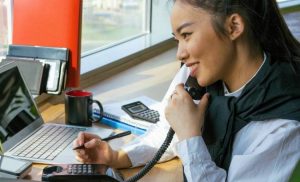Professional services websites often suffer from a number of common problems that hurt a firm’s ability to compete and engage its audiences. Let’s examine some of these problems so that you can begin to improve your own firm’s online presence.
1. Generic Look & Message
The majority of professional services websites don’t do a particularly good job of distinguishing themselves. Most of these websites blend blandly into the online landscape. They use the same tired visuals and vague language as their competitors — contributing to a homogenized and confusing marketplace, one in which buyers struggle to choose between poorly differentiated firms.
The best professional services websites avoid images like these:

Clichéd stock photos abound on websites across every industry. This visual noise communicates one thing loud and clear — that your firm lacks the imagination or confidence to be different. Most of these images share another trait, too. I call it “having a bad case of the blues.” For some reason, business stock photos tend to be blue-toned. As a result, many professional services websites have a similar feel, even when the specific subject matter in their images is different.
So next time you revisit your firm’s website design, make an effort to incorporate fresh imagery, colors and design elements into your site. Look at your competitors’ websites not as models to emulate, but as departure points — familiar ground to avoid.
If you look hard enough, you can find images that take a fresher approach. You may want to avoid standard business imagery altogether and take a more conceptual approach with your photography — selecting photos that depict more abstract themes. Or if you want to be more literal in your imagery, consider using illustration instead of photography. And if your site is one of the multitudes that use blue as a dominant color, look for a new color that’s less predictable.
2. Lack of Clarity (and Specialization)
Fuzzy writing infects an astonishing number of professional services websites. These sites speak in general terms about solutions but avoid specifying the problems they solve. Others hide their lack of specificity behind an impenetrable wall of jargon. Today the web has become an important tool clients use to vet possible vendors — if you can’t clearly communicate what you do on your website, you may never get a second chance.
Let me share an example taken from the website of a consulting firm:
[Company Name] is a strategy consulting firm that employs a combination of skills and methodologies to achieve significant bottom-line improvements. We view ourselves as value architects. Our quantitative understanding of the sources and levers of enterprise value enables us to identify for our clients how value can be created and sustained and how competitive advantage can be managed.
What does this company do? Beyond “strategy consulting,” it’s a head scratcher. This is the sort of fuzzy but impressive-sounding language that many firms use to disguise their lack of differentiation.
The prescription? Stand for something: a specific service offering, a vertical you serve best, or a special way you approach your trade. If you need help articulating your position with clarity, hire a skilled marketing copywriter to help you describe your services. In today’s web-centric marketing environment, clarity is one of the best investments you’ll ever make.
3. Out-of-Date Content
Does your website no longer reflect your current service offerings? Are the news headlines on your home page months or years old? You aren’t alone — many firms struggle to keep their web content up to date. But letting your content go stale can do a lot of harm.
Outdated web content can raise damaging questions in the minds of your prospects. “Where’s this firm’s attention to detail?” “Haven’t they done anything newsworthy recently?” “Can’t they afford to update their website?” Clearly, these are questions you don’t want anybody asking about your firm.
If the services described on your site don’t reflect what you offer today, you could be missing many valuable project opportunities. Our research shows that 99 percent of prospective buyers visit a firm’s website at some point during the buying process. Moreover, 80 percent use what they find on a firm’s website to help them decide whether to buy. And you’ll never even know about the many prospects who visit your website and rule you out. It happens more often than you think.

Your website is too important to ignore. Anybody who thinks about hiring your firm will make a stop — possibly an extended one — at your website, so you can’t afford to let it languish.
The best professional services websites are updated weekly or daily. Your site should be built on a content management system that makes it easy to add and delete content, as well as make quick corrections and updates. Make it a policy — and a habit — to keep your site accurate and fresh.
4. No Measurement
Web analytics are commonplace today. Most hosting services offer at least a rudimentary package, and several excellent web-based services are available for free, including the ubiquitous Google Analytics. So why do so few professional services firms use these tools as part of their marketing program?
Many professionals don’t realize how easy these tools can be to use — or what a wealth of useful information they provide. Google Analytics, for instance, presents much of its data in a clean, graphical format. You’ll discover how many people are visiting your site on any given day, what pages are most (and least) popular, how many times a PDF is downloaded, and where visitors come from. But that’s only the beginning.

With web analytics you can start to measure the effectiveness of your marketing tactics, discover what web content people actually want to read, and make critical adjustments to your website and your marketing campaigns. At last, you’ll be equipped to back up your marketing choices with hard data and make well-informed decisions that affect your leads, conversions and bottom line.
The best professional services websites are using analytics in sophisticated ways. For instance, they can segment their visitors and uncover how people from each group navigate their site. They can learn what pages or sequence of pages generate more conversions. And based on these insights they can make adjustments to their site structure, design, and messaging to facilitate a visitor’s journey. This produces more leads and higher revenues.
If you aren’t using analytics to gain at least a basic understanding of your web visitors, you are missing a huge opportunity to address the needs of prospect that find you — or vet your firm — on the web.
5. Assuming All Your Traffic Goes Through Your Homepage
Most people think of the path a person takes through a website like a tree, with an entry “trunk” that branches out into a multitude of sub-paths. In fact, that is the way most websites are structured. But it’s not necessarily the way all visitors experience your site. People don’t always follow the same path through the site or even begin in the same place. Many visitors (particularly those coming from search engines) may enter the site through an interior page, and they may jump around in a non-linear fashion.
In fact, on some sites the homepage plays a relatively minor role. At Hinge, for example, 90 percent of our web visitors enter through an interior page — and most of those entries occur on content pages.
When designing your site, it can be helpful to consider these non-linear visitors and their overall experience. This means ensuring that key messages appear on popular entry pages so that people aren’t disoriented when they arrive. You may want to place “offers” on key pages pointing to sections of your website that you believe visitors will find valuable. And “breadcrumbs” — those hierarchical text navigation trails at the top of some web pages — can help people orient themselves within your site structure.
It often makes sense to develop landing pages around marketing campaigns — special pages outside your normal website that speak to a specific audience. Assuming you have a web metrics package available, you will be able to measure response rates to individual marketing efforts. This will give you a foundation on which to build a powerful, metrics-based marketing program.
6. Ignoring SEO
Many professional services firms still don’t appreciate the value of search engine optimization (SEO). To ignore SEO is to turn your back on technology that helps prospects find you.
Even if you don’t generate a lot of business directly from the Internet, prospective customers and recruits need to be able to find you through Google and other search engines. As we described in section 3 above, the vast majority of your prospects will consult your website to help them make buying decisions. If they struggle to find you, your firm could miss valuable business opportunities. Regrettably, many professional services websites fail even at this most basic level.
Modern, standards-compliant websites are built in a way that makes them friendly to search engines — which is a great start. But if you want to make certain that people can find you and pave the way for Internet-based marketing in the future, you need to give serious consideration to keyword research, building your domain authority, and developing content that is crafted with your target audiences in mind. Don’t cede this advantage to your competitors.
7. Poor Accessibility
Accessibility isn’t just about helping a small number of visually impaired people “see” your website content. To a much greater degree, it’s about helping people who have no disabilities at all read the content on your website from a mobile phone or an older web browser. It’s about helping ordinary middle-age business people with imperfect eyesight be able to enlarge text on the screen. And for firms that contract with the government, accessibility is about complying with a set of government standards (Section 508) and demonstrating de facto support of those standards.
There is no excuse for building non-accessible websites today. When you redesign your website, insist on at least a minimal level of accessibility. It’s just good business.
Digital & Social Articles on Business 2 Community
(98)







